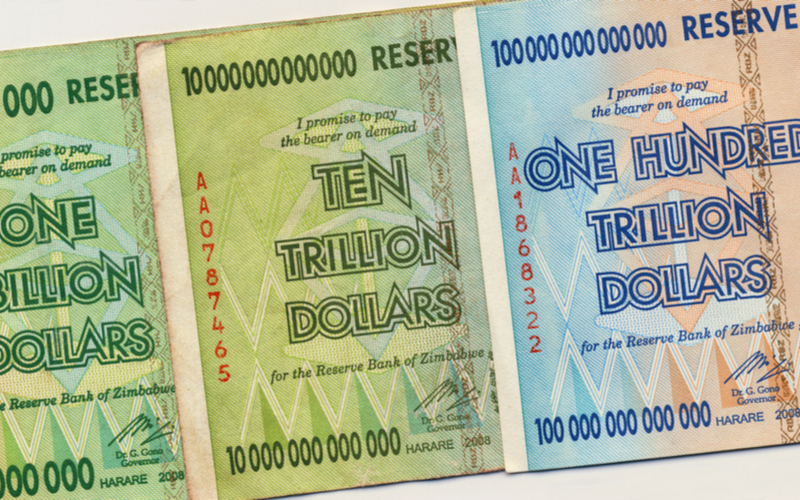Why Dollarization Doesn’t Work in Zimbabwe
Zimbabwe, a country bordering the northern border of South Africa, hands us many insights about the elements of sound money, by showing us what not to do. Zimbabwe systematically destroyed its own currency through the 2000s through a wild escalation of its own money supply, known as Zim dollars. The self-evident lesson of its resulting hyperinflation appears to be “too much money chasing too few goods.” Yet that’s a bit like blaming drug addiction on drugs.
Yes, drugs are the obvious culprit, but like hyperinflation, we need to investigate the underlying reasons for such destructive behavior. Moreover, replacing a country’s failed currency with a reserve currency such as the dollar – so called “dollarization” – is not as easy as it sounds.
My Experience
In 2006 I arrived in the capital city of Harare, Zimbabwe for the first time, after many years of research into this fascinating, if beleaguered country. The U.S. State Department had invited me to discuss how this once prosperous country- the so-called “jewel of Africa”- was now plunging into an economic collapse and hyperinflation which was soaring towards 1 million percent per year.
Before a group of business people, academics and government officials, I argued that the underlying cause was the government seizure of thousands of white-owned farms in the early 2000s. By crushing property rights, a domino effect began. Faith from outside investors evaporated and financial capital quickly exited the country towards safer havens. With no collateral or property titles for security, banks failed, along with tertiary enterprises such as textile and fertilizer companies.
Many of the best farms went to political cronies who had no experience in farming. They promptly sold irrigation pipes for scrap, auctioned off tractor equipment, and chopped down orchard trees to make a quick sale. Not surprisingly, the market for government securitized debt evaporated. Printing money became the order of the day. With a rapidly increasing deficit and collapsing tax revenue, Zimbabwe’s central bank- the Reserve Bank of Zimbabwe- made its Zim dollar a joke. By the end of 2008, it was printing 100 trillion dollar bills that wouldn’t buy a beer. The country had gone from a bread basket- a net exporter of grains- to a basket case, requiring food aid every year from the international community.
Dollarization
In January 2009, the government formally declared the U.S. dollar to be the official currency. This is known as dollarization, and it joined countries such as El Salvador and Ecuador in letting the United States determine the money supply. Dollarization is supposed to exact discipline on runaway government spending and clamp down on deficits. Indeed, there is little foreign or domestic appetite for lending to the Zimbabwe government, given its past track record of woeful mismanagement.
Yet the government deficits continue to grow. In 2017, the deficit was projected to be $400 million, yet it climbed to $1.82 billion, or 11.2% of GDP, mainly financed through Treasury bills and recourse to “overdraft” at the Reserve Bank. The raises some obvious but puzzling questions: Who is buying the Treasury bills? Who is lending to the Reserve Bank for “overdrafts”?
It appears that the Reserve Bank is raiding the coffers of private savers. After interviewing dozens of Zimbabweans during a visit this past May, all told me they had virtually no access to money in U.S. dollars from their own commercial banks. The official explanation is that there is a physical shortage of U.S. dollars.
There is some truth to this because Zimbabwe is running a trade deficit and has little capital investment as well. In other words, U.S. dollars are flowing out of the country faster than they are flowing in. But that can’t explain a near complete evaporation of dollars from the market economy. The reality is that commercial banks have been forced to trade their U.S. dollars for Zim-issued Treasury bonds, with no market value, in order to cover the Reserve Bank’s overdrafts.
The result is a headache in terms of everyday transactions that most of us take for granted.
In order to “solve” the cash shortage problem, the Reserve bank has printed up special “Zimbabwe bonds” which are touted as promissory notes, payable in U.S. dollars at any bank. Supposedly they work like a traveler’s check, except they are issued by the government. But with no U.S. dollars generally available from banks, they have become the new money of Zimbabwe, trading on the street for about 60 cents on the U.S. dollar. After a rapid depreciation, this exchange rate has held fairly stable in recent months. If you pay for something in U.S. dollars, you get change in Zim paper bonds and coins. Gresham’s law holds in Zimbabwe: the bad money drives out the good.
In order to stop further depreciation, the government has limited the amount of bond notes and bond coins, making even this “solution” problematic now. Even getting bond notes and coins out of the bank takes hours of queuing, which may end up with nothing on a bad day and 40 bond dollars on a good one.
With physical cash “unavailable” at the teller window or ATM, instead, there is a new “virtual cash” economy that is as strange a system as I have seen in my world travels. For people working in the formal economy- accountants, retail workers, engineers and so on, everyone now uses electronic dollars, which are simply represented by numbers in a bank account. These electronic dollars are worth about half what a U.S. dollar is worth on the street, according to local observers. A physical bond dollar is worth something in between a U.S. physical dollar and an electronic dollar.
There are 2 systems that move these virtual dollars around the economy: the “swipe” method- which is a debit card – and Ecocash which is a transfer done using the cell phone.
Salaries are directly deposited to bank accounts and a swipe card or Ecocash is used to electronically debit the account. This is used for everything from highway tolls, gasoline, grocery purchases, and everywhere else you might use a credit card. This “virtual money” has replaced the “real dollars” but with almost no physical cash to back it up. I brought U.S. dollars which were gratefully accepted at every retail establishment. However, I quickly learned I was a bit of a sucker paying the advertised “dollar” price in cash as many told me: “It’s expensive to spend U.S. dollars” since this was really 40 percent more than the “real price”.
The Problems
There are two significant problems with swipe cards and Ecocash. Banks function as intermediaries of this “island economy” with a virtual currency that cannot be used outside the country. Money in domestic Zimbabwe bank accounts, including international ones, cannot be wired to other international banks, since the U.S. dollars have been apparently raided by the Reserve Bank’s overdrafts. This type of arrangement makes the import-export businesses nearly impossible to operate without an extreme amount of ingenuity (which is in no short supply in Zimbabwe).
The second significant problem is that perhaps 80 percent of Zimbabweans attempt to scrape out a living in the informal economy without being able to use the electronic deposit system. They do not have access to electronic swipe depositing machines – and in the more far flung places do not have phone signal for Ecocash. These people line the roads with a handful of vegetables, or some clothing, hoping for a bit of bond cash and coin from the cars roaring past. No doubt these people are the most badly affected by Zimbabwe’s economic collapse in 2000, since many of them were employed in factories or on large-scale farms making far better wages.
The bottom line is this: the loss of trust is at the core of Zimbabwe’s problems. The trust broke as a result of land expropriations, as well as runaway deficits that ruined the currency through hyperinflation, and then post 2009 resulted in hard currency evaporating from people’s bank accounts. Pensions, savings and other assets resulting from years of hard work are all gone.
Adopting a relatively stable currency like the U.S. dollar will alleviate the greatest pains of hyperinflation, but is not the ultimate key to success for any economy. It is a necessary but not sufficient condition. It must be paired with a government that spends no more than it receives, pays attention to rule of law and has a welcoming business environment in entice foreign investors and visitors to bring their dollars. Without an earnest attempt to completely balance the budget, restore property rights and rule of law, and allow dollars to enter and leave the country, Zimbabwe’s economy will continue to be a shell of its former self in the 1980s and 90s.
The author thanks Ben Freeth, Executive Director of the Zimbabwe-based Mike Campbell Foundation, for his assistance in preparing this article.












